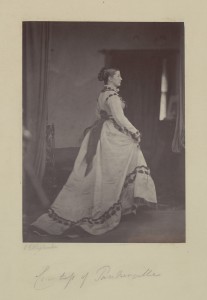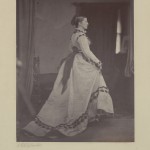The Ransom Center’s photography collection contains more than 100 photographs attributed to distinguished nineteenth-century photographer O. G. Rejlander. One print is a portrait of Olivia Bennet, The Countess of Tankerville. Researcher Lori Pauli visited the Ransom Center to study the portrait, and she reflected on the possible intersection of the lives of photographer and subject in a story which originally appeared in the Fall 2014 Random Edition newsletter.
The Harry Ransom Center’s renowned photography collection includes the only known print of a portrait of Olivia Bennet, The Countess of Tankerville, by distinguished nineteenth-century photographer Oscar Gustave Rejlander. This portrait is among more than 100 photographs attributed to Rejlander (British, b. Sweden, 1813?–1875) in the Ransom Center’s photography collection. Most are spread among four albums: one that formerly belonged to the British painter William Lake Price (1810–1896); another previously owned by British artist Cecil Gordon Lawson (1851–1882); a third known as the “Riglander” album; and the last an album compiled by writer Charles L. Dodgson (1832–1898), more famously known as Lewis Carroll. There are also ten loose prints attributed to Rejlander in the collection.
Among these loose prints is a portrait of a lady, shown standing in profile against a heavily draped window (fig. 1). Her intricately embroidered dress takes center stage, and at first glance it looks like a fashion plate. Below the image, however, is a handwritten title that identifies the woman in the photograph as the Countess of Tankerville. While it is true that fashion, and, more significantly, costume studies played a major part in Rejlander’s artistic oeuvre, it was the business of portraiture, and particularly images of the members of the higher ranks of London society, that constituted his professional “bread and butter.” Rejlander’s elegant portrait of the Countess of Tankerville is a good example of this aspect of his photographic production.
Born on July 18, 1830, Olivia Bennet (neé Montagu) was the youngest child and only daughter of George Montagu, the 6th Duke of Manchester, and his first wife Millicent Sparrow. Olivia spent her childhood at the family estate of Kimbolton Castle in Huntingdonshire, about 45 minutes north of London by train. It was at Kimbolton Castle that Olivia married Charles Augustus Bennet, Lord Ossulston, the 6th Earl of Tankerville (1810–1899), in January 1850. Following their marriage, the couple resided at Chillingham Castle, the seat of the Earl of Tankerville. Located in Northumberland, Chillingham was famous for its herd of all-white, wild cattle that had fascinated the famous nineteenth-century naturalist Charles Darwin.
The family divided their time between their estate in Northumberland and London. Like many in the upper class, the Countess—along with her eldest daughter Corisande and her good friend Jane Loftus, the Marchioness of Ely—visited one of London’s most frequented photography studios in London, that of Camille Silvy (1834–1910), located at 38 Porchester Terrace in Bayswater. The portrait session resulted in at least three photographs, each suitable for use in personal albums that were becoming common in drawing rooms across Europe (fig. 2).

In 1865, the Earl and the Countess were living at 19 Curzon Street in the fashionable Mayfair district of London, where they would continue to reside until about 1880. In 1866, Lady Olivia had her portrait made by Rejlander in his Malden Road studio. By this time, Rejlander had established a solid reputation as a portrait photographer, and his work was known to Queen Victoria and Prince Albert. It may have been through these royal connections that he came to make a portrait of the Countess of Tankerville. The Countess was also part of a social circle that included writers such as Thomas Carlyle (1795–1881), William Makepeace Thackeray (1811–1863), and Alfred, Lord Tennyson (1809–1892), as well as the famous Pattle family, including one of its most celebrated members, photographer Julia Margaret Cameron (1815–1879), an acquaintance and student of Rejlander’s.
Little is known about the Countess of Tankerville beyond accounts of her excellent singing voice and her record as an active social reformer and philanthropist. She was also an editor, illustrator, and writer; in 1884, for example, she published an essay titled A Bright Spot in Outcast London. As she explained in the text, the essay was intended to serve as a “voice on behalf of those who have long been toiling in the depth of its misery,” and to defend the work of the many charitable women and men who risked their lives to tend to the sick and helpless in London’s slums.
Distributed in pamphlet form, the essay was a response to a text written by Reverend Andrew Mearns in his pamphlet The Bitter Cry of Outcast London: An Inquiry into the Condition of the Abject Poor. Mearns’s text had galvanized public attention in Britain when it was published in 1883. Even before Mearns’s publication, the subject of urban poverty had been raised by writers such as Charles Dickens as early as 1836, and artists like Rejlander, whose staged study of a young boy in rags, known to many as Night in Town, Poor Joe, or The Outcast, became a visual symbol of the plight of the London poor (fig. 3).
The Countess of Tankerville published a second work in 1884, a book of poetry titled Life Songs, Being Original Poems. The book contains chromolithograph reproductions of watercolors and illuminations done by the Countess in collaboration with amateur artist and fellow philanthropist Louisa Beresford (née Stuart), the Marchioness Louisa of Waterford. The Countess died on February 15, 1922 in Tunbridge Wells, Kent, and her remains were interred at Chillingham.
We may never know if the Countess and Rejlander shared with each other their concern for the poor of London, but this photographic portrait of the Countess, in the prime of her life, is a singular record of their crossing paths.
Lori Pauli, Curator, Photographs Collection, National Gallery of Canada, is presently preparing a major retrospective on the life and work of photographer O. G. Rejlander that will open at the National Gallery of Canada in 2018.


